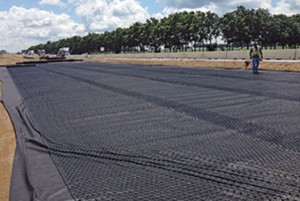Barnesville, Georgia Oct 9, 2019 (Issuewire.com) - Geosynthetics are synthetic products used to stabilize terrain. They are generally polymeric products used to solve civil engineering problems. This includes eight main product categories: geotextiles, geogrids, geonets, geomembranes, geosynthetic clay liners, geofoam, geocells, and geocomposites. The polymeric nature of the products makes them suitable for use in the ground where high levels of durability are required. They can also be used in exposed applications. Geosynthetics are available in a wide range of forms and materials. These products have a wide range of applications and are currently used in many civil, geotechnical, transportation, geoenvironmental, hydraulic, and private development applications including roads, airfields, railroads, embankments, retaining structures, reservoirs, canals, dams, erosion control, sediment control, landfill liners, landfill covers, mining, aquaculture and agriculture.
Geotextiles form one of the two largest groups of geosynthetics. They are textiles consisting of synthetic fibers rather than natural ones such as cotton, wool, or silk. This makes them less susceptible to bio-degradation. These synthetic fibers are made into flexible, porous fabrics by standard weaving machinery or are matted together in a random non-woven manner. Some are also knitted. Geotextiles are porous to liquid flow across their manufactured plane and also within their thickness, but to a widely varying degree. There are at least 100 specific application areas for geotextiles that have been developed however, the fabric always performs at least one of four discrete functions: separation, reinforcement, filtration, and/or drainage.
Growth in Governments Monitoring and Regulating the Disposal waste
- Governments are strictly monitoring and regulating the disposal of industrial and animal waste to prevent environmental degradation. The use of geomembranes and geosynthetic clay liners (GCL) as bottom-liners for waste containment, cut-off walls, and landfill enclosures and covers are mandated by environmental agencies. This is expected to positively impact market growth during the forecast period.
Development of Robust Membranes
- Geomembranes are used in a wide variety of applications such as liners for waste, radioactive and hazardous materials, and water conveyance canals. They are also used as covers for landfills, power plants, and provide water-proofing solutions. The increased use of geomembranes drives the demand for strong, robust, and rigid geomembranes.
Rapid urbanization along with favorable government initiatives to improve infrastructure will favor housing, transport, construction, and energy industries, thereby driving geosynthetics market size. Increasing environmental concerns along with the shift in consumer trends towards green buildings and material should positively influence industry growth.
Strict environment norms implemented by EPA and REACH for construction industries coupled with an increase in infrastructure spending in the residential sector owing to the massive movement of migrants to western countries and rising living standards of consumers should propel industry growth. Growth in geotextile market size is expected in construction applications due to superior characteristics such as tensile strength, porosity, flexibility, permeability, and compatibility should boost geosynthetics demand. However, volatile raw material prices may hamper the growth of the market
Browse key industry insights @ https://www.merkleandsears.com/Global+Geosynthetics+Market+Analysis
The Geosynthetics market is segmented on the basis of its Product, Function, Application, Landside, and Region. Global Geosynthetics market can be segmented into various key segments depending on the type of product, material types and on the basis of region.
Based on the type of product, the global geosynthetics market can be segmented into geotextiles, geogrids, geocells, geomembranes, geocomposites, geosynthetic foams, and geosynthetic clay liners. Geotextiles are geosynthetics made up of woven (fibers on cloth-like material) and non-woven (randomly oriented fiber) materials geogrids are used for stabilization and reinforcement of waste masses, geocells are used in earth retention applications, railroad support, for protecting bunkers and walls. Geofoams are lightweight blocks that act as void filling materials in certain construction applications. Lastly, geosynthetic clay liners are fabric-like materials used for the lining of landfills.
The geosynthetics market is segmented into six types: geotextiles, geomembranes, geogrids, geofoams, geonets, and others. It is expected to show high growth owing to evolving environmental protection regulations and standards to boost the future growth of geosynthetics.
Make an inquiry for purchasing this report @ https://www.merkleandsears.com/contact-us.php
North America is expected to remain one of the key markets for geosynthetics particularly the geomembrane industry. This market has witnessed a moderate growth owing to the maturity level of geosynthetics products in the infrastructural developments and construction projects. The U.S. held the largest share of the market in North America.
Within the framework of the construction of Europe, certain national regulations of the member states have been harmonized on the basis of the European directives. For construction products, the corresponding directive defines the essential requirements the products shall fulfill to be allowed to be placed on the Euro-pean market. The essential requirements are mechanical resistance and stability safety in case of fire hygiene, health and environment safety in use energy economy and heat retention.
Some of the major players in the Geosynthetics market are Solmax International, Low & Bonar PLC, Strata Systems, Royal Tencate NV, Propex Global, Raven Industries Inc., Tensar International Corporation Inc., Asahi Kasei Corp., Berry Global, Inc., E.I. Dupont DE Nemours And Co., Saint-Gobain, Solvay SA.
Contact:
David Garrision
+1 678-701-8226
info@merkleandsears.com
Media Contact
Merkle and Sears - Market Research info@merkleandsears.com +1 6787018226 https://www.merkleandsears.com










